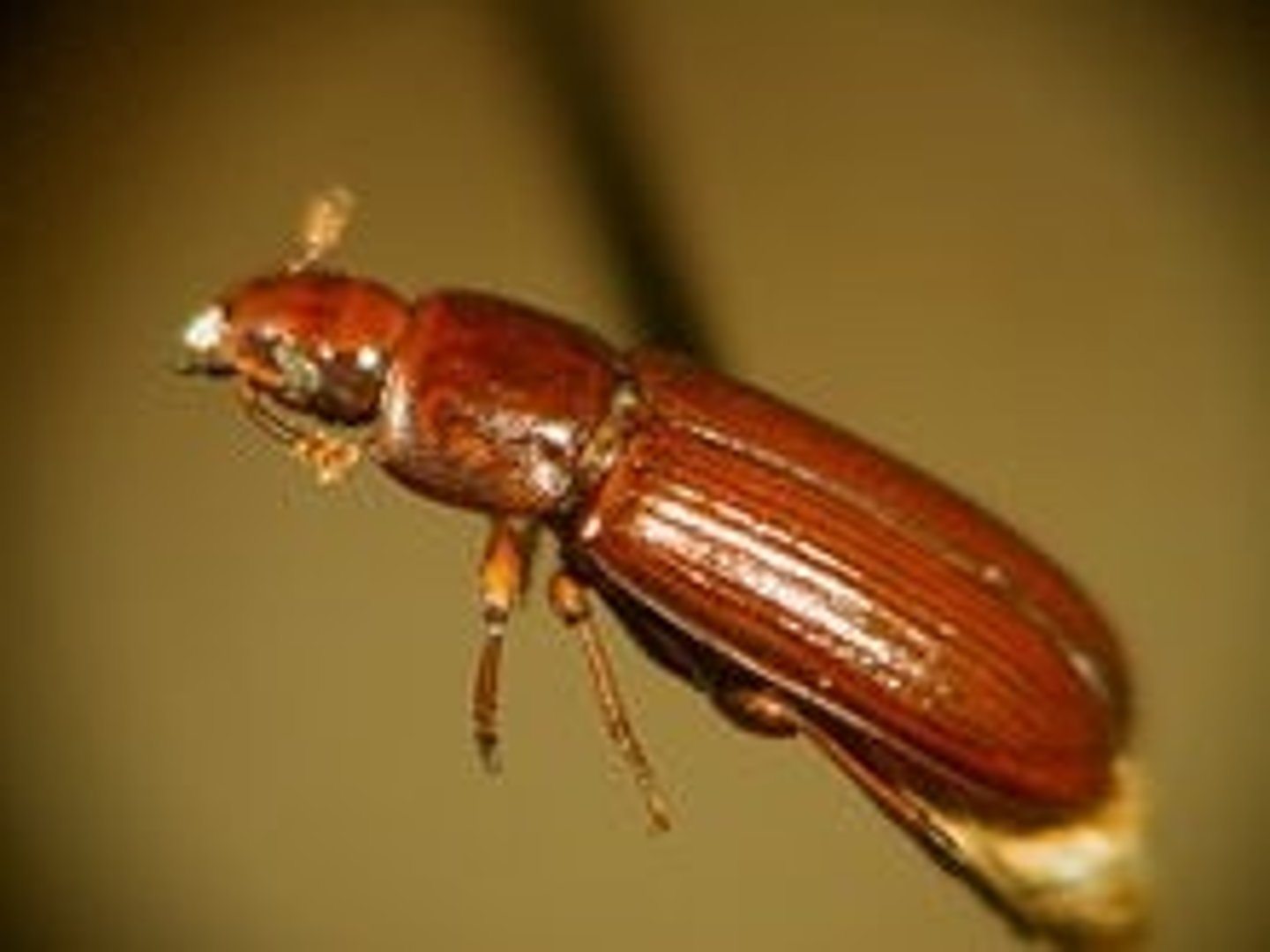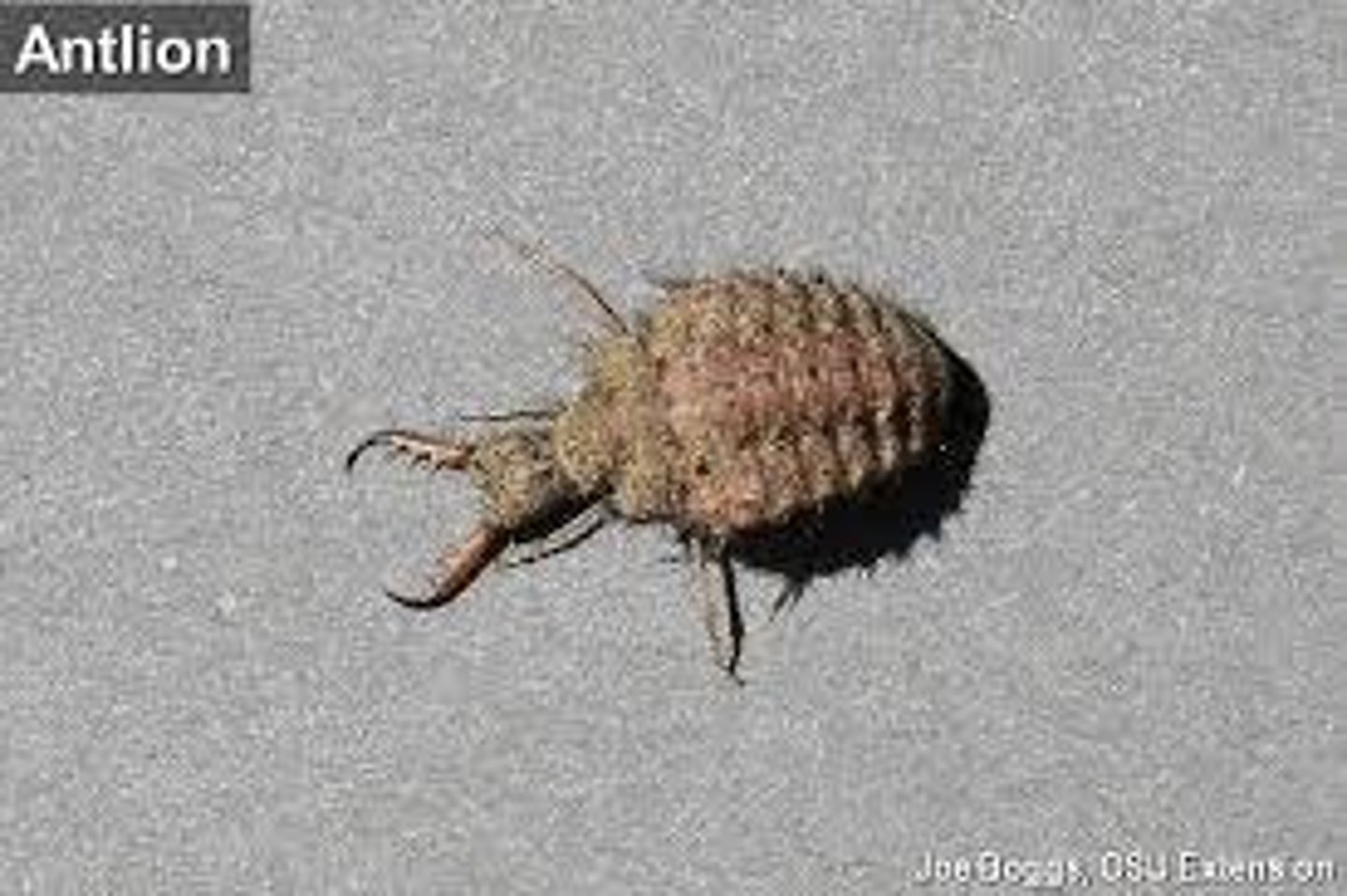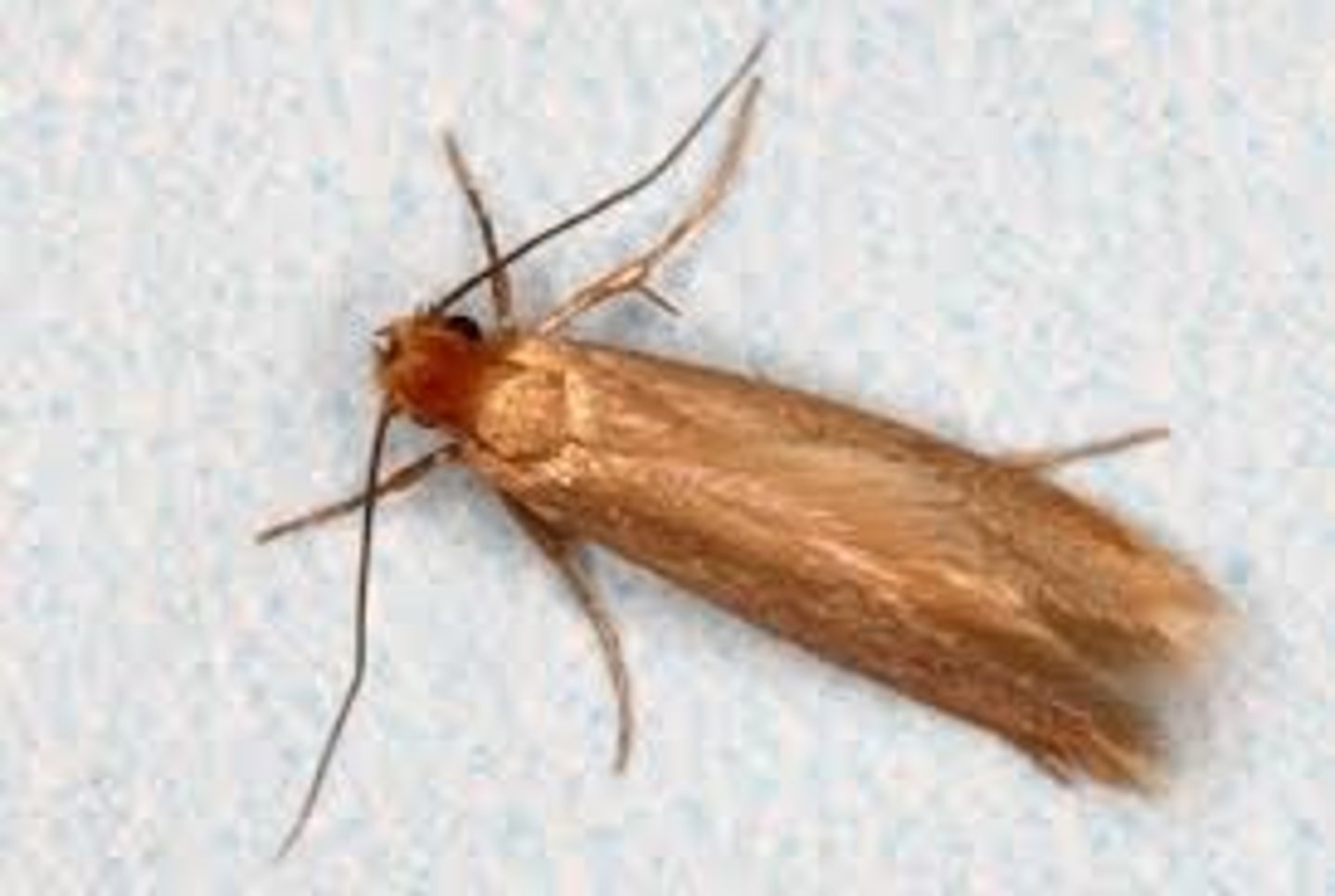ENTM 010 FINAL
1/119
There's no tags or description
Looks like no tags are added yet.
Name | Mastery | Learn | Test | Matching | Spaced |
|---|
No study sessions yet.
120 Terms
Africanized "killer" bees
Increased defensiveness - whole colony attacks
European honeybee + African honeybee
A. Mellifera Scutellate
Very aggressive (hunt bee hives)
Almond flower pollination in CA
Honeybee hives are brought in from around the U.S. (2 hives per acre)
In almond blossom, >80% of all available commercial hives in the U.S. are in CA
Ant antennae
Geniculate antennae "elbow shape"
Used to smell, touch, feel, and communicate
Ant feeding habit
Adult feed on liquid
Trophallaxis food exchange
Argentine ant biology
Major urban pest because they protect pest insects (hemoptera)
who produce honeydew
Bite but cannot sting
Shallow nest in soil under rocks, logs, stepping stones, pavement
Army ant biology
Aggressive predatory foragers
Built temporary nest through bivouac (use own body to create nest)
Large mandibles
Use chemical trail because their eyes are not the best
Armyworm
Moth larvae that will eat anything in its path
Nocturnal larvae
Biological invasion
Increases environmental/ economic costs
Threat biodiversity because they spread diseases
Alter stability and quality of ecosystem
Blackfly and disease
Vector of River Blindness
Causative agent in parasitic nematode
Nematode enter wound → develop into worm→ mature and migrate through the skin
Symptoms = severe itching, bumps under skin
Blackfly biology
Order: diptera
"Fan-like" structure (labral fan) surrounding mouth
Helps intake organic debris carried in water
Family: simuliidae
Male feed on nectar
Female require blood to mature eggs
Larvae are aquatic
Adult is a major pest
Holometabolous (complete metamorphosis) [egg, larvae,pupa, adult]
Causative agent in parasitic nematode
Blow flies in forensic entomology
Use of maggot therapy to heal wound
Blowflies can locate dead flesh within minutes
Give estimated time of death
Cabbage butterfly
Only lay eggs on plants containing glucosinolate
Major pest
Cabbage looper
Part of Noctuidae family
The caterpillar larvae are major pests
Caddisfly
"Hair wigs"
Aquatic larvae
Uses material to make shell to protect themselves feed on algae
Holometabolous (complete)
California dogface butterfly
Only found in California
Wings mimic a dog's face
Casemaking clothes moth
Larvae construct ases from fabric and carpets
Characteristics of Lepidoptera
From "lepis" meaning scale and "ptera" meaning wing.
Wings are covered in scales
Holometabolous development
Cockroach and allergen
The ones considered pests are brown-banded, German, American, and oriental.
A source of allergens and asthma triggers
Crane fly biology
Family Tipulidae
Stilt-like legs may be easily shed (defensive mechanism)
Larvae can be important soil engineers
Dance language of honeybee
Wobble dance to tell other bees where pollen is
Tells direction and distance from sun
Diapause
A period of dormancy in which many insects undergo to avoid adverse condition
Disease and body louse
Human body lice transmits epidemic typhus fever
Dobsonfly
Adult have huge mandibles
· Larvae aquatic
· Voracious predators
Dung beetle biology
roller, dweller, tunneler
Dispose of waste
There be more flies without dung beetle
Ecdysone
A hormone that controls molting in insects and other arthropods
Secreted from prothoracic glands
Ephemeroptera
Hemimetabolous, yet has two stages (subimago and imago) after nymphal stage. Unique to only this order and fairly dies shortly after becoming an adult. large triangular wing, 1 caudal filament & 2 cerci. adult terrestrial, nymphs aquatic. Ex. mayflies
Etymology of Hymenoptera
The Ancient Greek "hymen" meaning "membrane"
> 150,000 recognized species
Evolved ~ 250MYA
Diverse order!
Complete metamorphosis
Holometabolous
Egg-larva-pupa-adults
Larvae look different from adults, adults in different environments
Hormonal control of development
Endysone and corpora allata
Complete metamorphosis
Hornet
Very aggressive they hunt bees
But Japanese honeybees evolved with the Japanese hornets
Tsetse fly and disease
Vector of sleeping sickness
Tsetse fly reproduction
Adenotrophic viviparity: "gland fed, life birth"
Tympanal organ locations
katydid/ cricket = front tibia
Grasshoppers = 1st ab segment
Use of stingers in ants
Defense, hunting, trail pheromone
Yellowjacket
In hawaii
Decrease native insect by predation
Yucca and yucca moth
Females collects pollen and deposits pollen at new flower if pass inspection
Lay eggs in one ovary
Marks flower with pheromone
Hornworm
Larvae of moth
· Major pest of tomatoes
· Cryptic coloration
Horsefly feeding
Adults: stout bodied powerful fliers with large eyes
Both sexes feed on nectar
Females use mandibles and maxillae to lap up blood for the pool
Hymenoptera sex determination
diploid: two copies (female)
haploid: one copy (males); unfertilized
*if females clone then it is haploid; females control how she has her eggs
Maggot therapy
Debridement: medical removal of dead, damaged, or infected tissue to improve the healing potential of the remaining healthy tissue
Disinfection: fly maggot secrete several different compound that have broad-spectrum antimicrobial activity (uric acid, allantoin, anomia)
Moths vs. butterflies
Often feather-like (bipectinate or thin antennae
vs
Thicker, with bulbs or hooks on end
Osmeterium
Defensive organ of caterpillars that emits odorous chemicals
Pheromones
Chemical signals between individuals within the same species
Phorid flies and ants
Some are parasitoids of ants and can be used in biocontrol
Ant decapitating
&
Family formicidae
Ants are eusocial (small workers: nurses, medium workers: colony maintenance and foraging, large workers: soldier)
Pollen basket
Hide basket on their hind leg tibia
Royal jelly
-A protein-rich secretion from the glands in the heads of workers bees
-Fed to all bee larvae, whether they are destined to become drones, workers, or queens
-After few days, drone and worker larvae are fed with it
-But, queen larvae continue to be fed this substance throughout their development > morphological/physiological differentiation (reproductive, longevity, etc)
Sandfly and disease
Leishmaniasis disease
Scansorial leg
For clinging
Found on true lice
Scopae
A tuft of hairs on the abdomen of leafcutter bees; used for collecting pollen
Scorpionfly
Males have enlarged genitalia aka tail, used for reproduction
Females do not have the tail
Silkworm moth
Family bombycidae
Adaptive to overcrowded conditions
Silverfish
Indirect sperm transfer with courtship
Sound production in Orthoptera
Orthoptera make sounds by rubbing body parts
Grasshoppers rub hind legs against the edge of closed wings
Crickets stridulate with the wings only
Swallowtail
Papilionidae
type of butterfly has yellow with black stripes, feed on citrus, fly well and use osmeterium
Tiger beetle larvae
Predacious, quite aggressive
Have burrows they pop out to grab prey, "sit-and-wait" predators
Think of the video of the researchers using string and bait to "fish" out the larvae from their holes
Parasitoid vs. predators
-parasitoid: needs only one host to complete life cyle
-predator: needs a lot of prey to complete one life cycle
Jewel beetle biology
family buprestidae
-description = texture cuticle, shiny/metallic, thin film interference
-diet = wood of trees
-some are pryphils, organs sensitive to radiations
-can detect radiation from heat and fires; forest fires
Larvae and adults in Diptera
Larvae and adults are very different thus allowing them to coexist in the same environment or area but cover different niches and not compete with one another for resources.
Etymology of Lepidoptera
Butterflies and moths
Lepidpo = scale
Ptera = wing
Eusociality
Truly social (ants, bees, wasps, & termites)
Live in groups as adults
Cooperative brood care
Reproductive division of labor
Communicate by smell & sound (not sight bc the nest is usually dark)
Firefly bioluminescent organ
Luminescent organ on abdomen
Involves specialized cells, photocytes [responsible for producing light]
Luciferin, luciferase, energy, oxygen
Highly efficient [no heat created, energy goes into light production]
Lights used to attract mates [adults]
Haltere
Modified hind wing used as gyroscopes in true flies
Tribolium castaneum "red flour beetle"
Tiny beetles, only require flour and a small container, small pupa growing in flour, extremely adaptive to dry flour broken seed, don't need much water, they generate moisture by metabolising the flour, adaptive to storage system, stored product pest,

Springtail Order name: collembola
Hexapod of the day
· One pair of antennae, six legs, their tail hides underneath their body & springs out
· Like a kiwi version of a hexapod

"Spittle bug" - member of auchenorrhyncha
- immature
- Balls of foam on rosemary, stays around for a while
- Insect looks like a peanut dipped in chocolate
Sucks juice out of rosemary plant
- Makes form with the tip of abdomen
-Protection from dry/high temperatures, good in extreme conditions

Cochineal Scale Big
Live on prickly pear cactus [opuntia cactus]
The females stay on the cactus and never leave
They produce a sticky wax as a protective cover
They eat and lay eggs in one place
They suck the juice from the cactus
Mouth part is embedded in plant tissues
The males has wings to disburse DNA
When squished it produces a red dye pigment from its tissue
Cochineal dye [Carmine Acid]
![<p>Live on prickly pear cactus [opuntia cactus]<br>The females stay on the cactus and never leave<br>They produce a sticky wax as a protective cover<br>They eat and lay eggs in one place<br>They suck the juice from the cactus<br>Mouth part is embedded in plant tissues<br>The males has wings to disburse DNA<br>When squished it produces a red dye pigment from its tissue<br>Cochineal dye [Carmine Acid]</p>](https://knowt-user-attachments.s3.amazonaws.com/4bd1bc32-b99b-44a6-83a9-cdfb57fcbeb2.jpg)
Crane fly (Tipulidae)
Looks like a mosquito but bigger
Active during spring, after the rain, and at night
During the day it rests on trees
Emerges from the soil, flies low to mate and lay eggs
Lays eggs in the ground, the larva stays in the soul and looks like a maggot
Has halteres

Thrips, Thysanoptera.
Tiny, less than 1 millimeter long
Sucking mouth part, eats plant tissue, sucks the juices
Found near flowers [roses], lives in plants & small areas, likes to hide in protected shaded area
Fringe wings
![<p>Tiny, less than 1 millimeter long<br>Sucking mouth part, eats plant tissue, sucks the juices<br>Found near flowers [roses], lives in plants & small areas, likes to hide in protected shaded area<br>Fringe wings</p>](https://knowt-user-attachments.s3.amazonaws.com/b974fc9f-41bc-41cd-af0e-38c9bf4b3626.jpg)
Antlion (Myrmeleontidae)
The larva has a very hairy pineapple looking body -> cocoon -> adult looks like a dragonfly
Their hair collects dust/dirt to blend to surroundings
Consumes ants by trapping them in the soil
Uses mandibles to inject venom into their prey and juices them
Nocturnal as an adult

silkworm moth

Case making clothes moth

Dark rover ant

Sound production in Orthoptera
Orthoptera make sounds by rubbing body parts
Grasshoppers rub hind legs against the edge of closed wings
Crickets and katydids stridulate with the wings only
Swallowtail
Papilionidae
type of butterfly has yellow with black stripes, feed on citrus, fly well and use osmeterium
Sweat bee
Attracted to salt in sweat
Ground nesting
Mass provisioning
Pollen fed/pollinators
Tiger beetle larvae
Predacious, quite aggressive
Have burrows they pop out to grab prey, "sit-and-wait" predators
Think of the video of the researchers using string and bait to "fish" out the larvae from their holes
Timing of successful eradication
applies to farmers and the eradication of pests. If the farmers time the use of pesticide correctly, then they can potentially eradicate pests for an entire year
Evolution of hexapods
Springtails, diplurans, proturans
concealment of mouthparts within head capsule
Fire ant adaptation
Fire ants can link together to form a raft during flash floods
Foraging strategies in Myrmicinae
Seed-harvesting (eg, harvester ant, fire ant)
Fungus-growing (eg, leaf cutter ant)
Forensic entomology
We can get a good estimate of time of death by looking at insect activity around the body
Blow flies are useful for this estimation
Formic acid
A defensive secretion in some ants
Sprayed
Glucosinolates
Glucosinolates are natural components of many pungent plants such as mustard, cabbage, and horseradish
The pungency of those plants is due to mustard oils produced from glucosinolates when the plant material is chewed, cut, or otherwise damaged
Natural insect repellent
Gossamer-winged butterfly
family lepidoptera
small body size and less colorful than other families
diverse in their food habits: phytophagy, entomophagy
75% species have an ant-association
Gulf fritillary
Species of butterflies from Family Nymphalidae (brush-footed butterflies)
Bright orange, long narrow wings
family: nymphalidae
order: lepidoptera
largest family of butterflies
larvae have defensive spikes on body
hamulate
wing of hymenoptera
wing-coupling mechanism
in flight are joined by hooking hamuli on one wing into folds on a matching wing
Harvester ant
Common name for any of the species that collect seeds or mushrooms which are then stored in communal chambers called granaries
Hemolymph functions
Insect blood
Transports nutrients, waste, and hormones
Holometabolous
Egg-larva-pupa-adults
Larvae look different from adults, adults in different environments
Hormonal control of development
Endysone and corpora allata
Complete metamorphosis
Hymenoptera biology
-ants, bees, and wasps
complete metamorphosis
-2 pairs of wings (hamulate: hooks) and compound eyes
-chewing and lapping mouthparts
-stingers (modified ovipositor)
-larvae pupate in apocrita
Impacts of invasive species (biological invasion)
threaten ecosystem stability = generate significant environmental and economic cost
threaten biodiversity, spread disease
alter stability and quality of ecosystem processes
Leaf-cutter bee
Order: Hymenoptera
Family: Megachile
use abandoned nests and cavities.
have a tuft of hair on the abdomen used to collect pollen (scopae)
Juvenile hormone analogs
JH regulates development, reproduction, diapause and polyphenism
ensures growth of larvae, while preventing metamorphosis
because of rigid exoskeleton, insects grow in their development by shedding their exoskeleton (molting)
JH is secreted by pair of endocrine glands behind the brain
also important for the production in eggs in females
Lacewing
order neuroptera
family chrysopidae
larvae are biological control pest in agriculture and gardens
have ears near bases of forewing (detect when predators are near)
carry dead bugs in back to camouflage
Leafcutter ants biology
cut off leaves and store them until they grow fungus, which they eat
Lycaenidae biology
gossamer-winged butterflies
small in body size and less colorful than other families
diverse in their food habits: phytophagy, entomophagy
(75%) larvae associated with ants
master manipulators = nest parasitism
Nesting habits in wasps
social insects with a queen
new nest every year and is constructed out of wasp paper made by chewing wood and other plant debris mixed with saliva
no wax producing gland
Nymphalidae leg
Adults have reduced forelegs
Stand only on 4 legs while the other two are curled up
Onychophora
Commonly known as velvet worms
Soft flattened segmented bodies
Antennae, simple eye
Many legs with claws
Prey on smaller insects
Tropical
Parasitoid vs. parasite
Parasitoid: needs only one host to complete life cycle
Robber fly biology
family asilidae
predacious / mimic bumble bee
stylet mouthparts surrounded by hairy beard
concave depression head between compound eyes